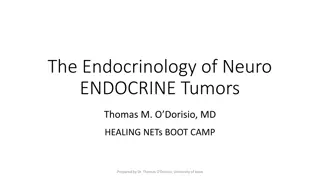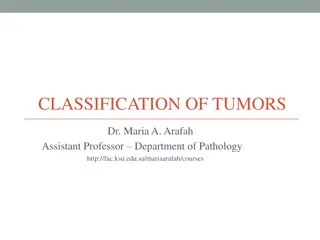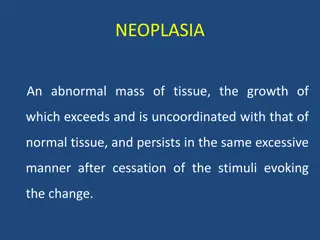Understanding Neoplasia: Characteristics and Nomenclature of Tumors
Neoplasia, or new growth, is characterized by uncoordinated growth exceeding that of normal tissues, persistent growth independent of stimuli, loss of responsiveness to growth controls, and local expansion regardless of host environment. Tumors are classified into benign and malignant categories in oncology based on behavior. The nomenclature of tumors includes parenchymal and supporting parts, with benign tumors named based on cell origin and the suffix "-oma." Specific benign tumors like chondroma, adenoma, papilloma, polyp, and cystadenoma have distinct characteristics.
Download Presentation

Please find below an Image/Link to download the presentation.
The content on the website is provided AS IS for your information and personal use only. It may not be sold, licensed, or shared on other websites without obtaining consent from the author. Download presentation by click this link. If you encounter any issues during the download, it is possible that the publisher has removed the file from their server.
E N D
Presentation Transcript
NEOPLASIA (New growth) DR.AYSER HAMEED LEC.1
Abnormal mass of tissue, characterized by followings:- 1.Its growth is uncoordinated & exceeded with that of the normal tissues. 2.Neoplasm persist its growth after the cessation of stimuli which cause the change. 3.Loss of responsiveness to normal growth controls (Autonomous). 4.Tumors increase local size regardless of their local environmental & nutritional status of the host.
Neoplasia mean tumors Oncology: is the science that studies the tumors. Oncology divided tumors according to their behavior into (Benign & Malignant).
Nomenclature of Tumors: All tumors (benign & malignant) have two basic parts: 1.Parenchymal Part: Formed by neoplastic cells. 2.Supporting part: Made up of blood vessels & connective tissue. Parenchymal Part:- Determine the clinical behavior of tumors. Derived the name of tumors. Naming of Benign tumors: (Cell of origin of tumor + Suffix Oma), like:- Fibroma (benign tumor of fibrous tissue). Chondroma (benign tumor of cartilage).
Chondroma The tumor has lobules of benign-looking chondrocytes
Certain Benign Tumors or lesions 1. Adenoma: benign epithelial neoplasm producing glandular pattern or benign neoplasm derived from glands e.g. Renal Adenoma, follicular adenoma of thyroid. 2. Papilloma: Any benign neoplasm growing on any surface that produce microscopic or macroscopic finger like fronds, as in the skin. 3. Polyp: is a mass that projects above a mucosal surface, as in the gut. Some malignant tumors appear as Polyp (mainly in the colon). 4. Cystadenoma: are hollow cystic masses, typically seen in the ovary.
Follicular adenoma thyroid A portion of another follicular adenoma consisting of small (micro) follicles.
Squamous cell papilloma larynx This multilayered benign-looking squamous epithelium is arranged in a finger-like projections, each having a core of vascularized connective tissue. The Rt. Photo is a higher power showing the squamous epithelium cover of one of the papillae.
Ovarian cystadenoma and papillary cystadenoma Lt, a cystadenoma seen as a unilocular, thin-walled cyst with smooth inner & outer surfaces. Rt, papillary cystadenoma having similar gross features to cystadenoma except for the presence of multiple yellowish, warty projections sprouting from the inner surface.
Naming of Malignant Tumors 1.Malignant neoplasm arising in mesenchymal tissue or its derivatives are called Sarcoma, e.g. Fibrosarcoma (malignant neoplasms of fibrous tissue). Chondrosarcoma (malignant neoplasm of cartilage). Osteosarcoma (malignant neoplasm of bone). 2. Malignant neoplasms of epithelial cells origin are called Carcinoma. These epithelia are derived from germ layers, e.g. renal cell carcinoma (Mesoderm), Squamous cell carcinoma (ectoderm).
So mesoderm can give rise to carcinoma as well as Sarcoma. Sometime the type of malignant epithelia gives the name of malignant tumor, like 1.Squamous cell carcinoma: tumor cells resemble stratified squamous epithelium. 2.Adenocarcinoma: tumor cells grow in glandular pattern. Sometime the tissue of origin can identify by the name of tumor, like 1.Renal cell carcinoma. 2.Hepatocellular carcinoma.
Tumors can be divided according to their origin: 1.Monoclonal tumor: Malignant tumor in which the cells are derived from single progenitor cells (single germ layer). 2.Mixed tumors: tumors in which the stem cells may undergo divergent differentiation, like pleomorphic adenoma of parotid gland which contain two parts (epithelial part & fibromyxoid part). Another example of mixed tumor is fibroadenoma of breast which consist of two parts (Adenoma & fibroma).
MIXED PAROTID TUMOR (Pleomorphic Adenoma) Two clinical examples of parotid pleomorphic adenomas. These tumors classically present as preauricular swelling. In the early stages the tumor is small but it may progressively increase in size if left untreated. The Rt. Photo is an usually large pleomorphic adenoma. The only way of establishing the diagnosis & excluding malignancy is through microscopic examination of sections from the excised tumor. This has revealed features of pleomorphic adenoma in these two examples.
Mixed salivary gland tumor (Pleomorphic adenoma) Sheets of epithelial/myoepithelial cells with glandular arrangement. There are several nodules of cartilaginous tissue composed of chrondrocytes within a bluish background. The capsule of the tumor is to the Lt.
3. Teratoma: A tumor contains recognizable mature or immature cells or tissues, which are derived from more than one germ layer (sometime from three germ layers). These teratomas are arising from totipotential cells mainly in the ovary & testis. May contain:- Bone, muscle, fat, hair (these are mesoderm derivatives). Epithelia (respiratory, intestinal), this is endoderm derivative. Nerve (ectoderm derivatives).
If all components of teratoma are benign, is called mature teratoma typically seen in ovary. If these components are immature, this is called immature teratoma (Malignant potential), typically seen in testis.
Ovarian Cystic Teratoma (Dermoid cyst) Well-developed teeth in ovarian mature cystic teratoma.
Tumor like lesions 1. Hamartoma: is a malformation that present as a mass of disorganized tissue indigenous to the particular site. e.g. Hamartoma of lung. 2. Choristoma: is a congenital anomaly, it is heterotopic rest of cells. e.g. small nodule of pancreatic tissue may be found in the submucosa of stomach, duodenum & small intestine.
PULMONARY HAMARTOMA Pulmonary hamartoma. The lesion is subpleural, is well circumscribed, and has a glistening cut surface. A mixture of cartilage, respiratory epithelium and fat
Important note: Lymphoma, melanoma, mesothelioma & meningioma, although they are end with suffix oma, they are malignant tumors. Characteristics of Benign & Malignant tumors: Characteristics of differentiation between benign & malignant tumors are:- 1.Differentiation & anaplasia. 2.Rate of growth. 3.Local invasion. 4.Metastasis.
I. Differentiation & anaplasia: Parenchymal part of tumor is responsible for differentiation & anaplasia of tumors, while the stromal part of tumors is important for growth of tumor because it contains blood supply of tumors. Differentiation of Parenchymal cells refers to the extent to which the tumor cells resemble their normal original tissue morphologically & functionally.
Leiomyoma Sections from a leiomyoma show interlacing bundles of benign smooth muscle cells that simulate very closely their native counterparts.
Benign tumors composed of well differentiated cells (closely resemble their normal counterpart), e.g. Lipoma (consist of mature adipose cells). Chondroma (consist of mature chondrocytes). Mitosis is extremely rare in number in benign tumors. Malignant tumors characterized by wide range of parenchymal cell differentiation (from well differentiated to undifferentiated & anaplasia).
Well-differentiated squamous cell carcinoma of the skin The tumor cells are strikingly similar to normal squamous epithelial cells, with intercellular bridges and nests of keratin pearls (arrow).
Anaplasia: means loss of structural & functional differentiation of normal cells. Characteristics of anaplastic cells: 1.Pleomorphism (variation in the size & shape of cells). 2.Large hyperchromatic nuclei. 3.Increase Nucleus/ Cytoplasm (N/C) ratio (1:1), normally it is (1:4 or 1:6). 4.Anisonucleosis (variation in the size of nucleus) & poikilonucleosis (variation in the shape of nucleus).
5. Chromatin is coarse, large prominent nucleolus. 6. Numerous, atypical mitosis. 7. Loss of normal orientation of cells (loss of gland formation). According to degree of differentiation: three grade of differentiation of malignant tumors, 1.Well differentiated malignancy (like normal tissue). 2. Moderately differentiated malignancy. 3.Poor differentiated, undifferentiated, anaplastic malignancy.
Important notes: Usually benign & well differentiated cancer have functional capacity e.g. like well differentiated malignancy of endocrine glands secrete hormones resemble the normal endocrine cells
Degrees of differentiation Normal adenoma carcinoma
Undifferentiated (Anaplastic) Cancer Complete loss of differentiation (primitive cells). Frequent mitoses including abnormal ones Cells/nuclei show marked pleomorphism/sometimes multinucleated tumor giant cells Extreme nuclear hyperchromasia Marked nuclear enlargement N:C may reach 1:1 (instead of 1:4 or 1:6) The chromatin is coarsely clumped and irregularly distributed Usually large, prominent nucleoli
Rhabdomyosarcoma Pleomorphic rhabdomyosarcoma showing prominent pleomorphism, frankly malignant nuclei & malignant multinucleated giant cells.
Dysplasia: It is non-neoplastic growth disorder; mainly occur in epithelia (not stroma). It is a loss of uniformity of the individual cells & a loss in their architectural orientation. Characteristics of dysplastic cells: 1.Pleomophism. 2.Large, hyper chromatic cells. 3.Mitosis more than normal (mitosis not restricted to the basal layer, it involves the all layers). 4.Loss of normal maturation of cells e.g. loss of maturation of squamous epithelium.
When dysplastic changes involve the entire thickness of the epithelium, they are called Carcinoma in Situ or preinvasive stage of cancer. However; foci of carcinoma in situ can present adjacent to area of cancer. Dysplasia does not necessarily progress to cancer & dysplasia not involve full thickness may be reversible.
Cervix uteri severe dysplasia amounting to carcinoma in situ There is failure of normal differentiation, marked nuclear and cellular pleomorphism, and numerous mitotic figures extending toward the surface. The intact basement membrane (below) is not seen in this section.























